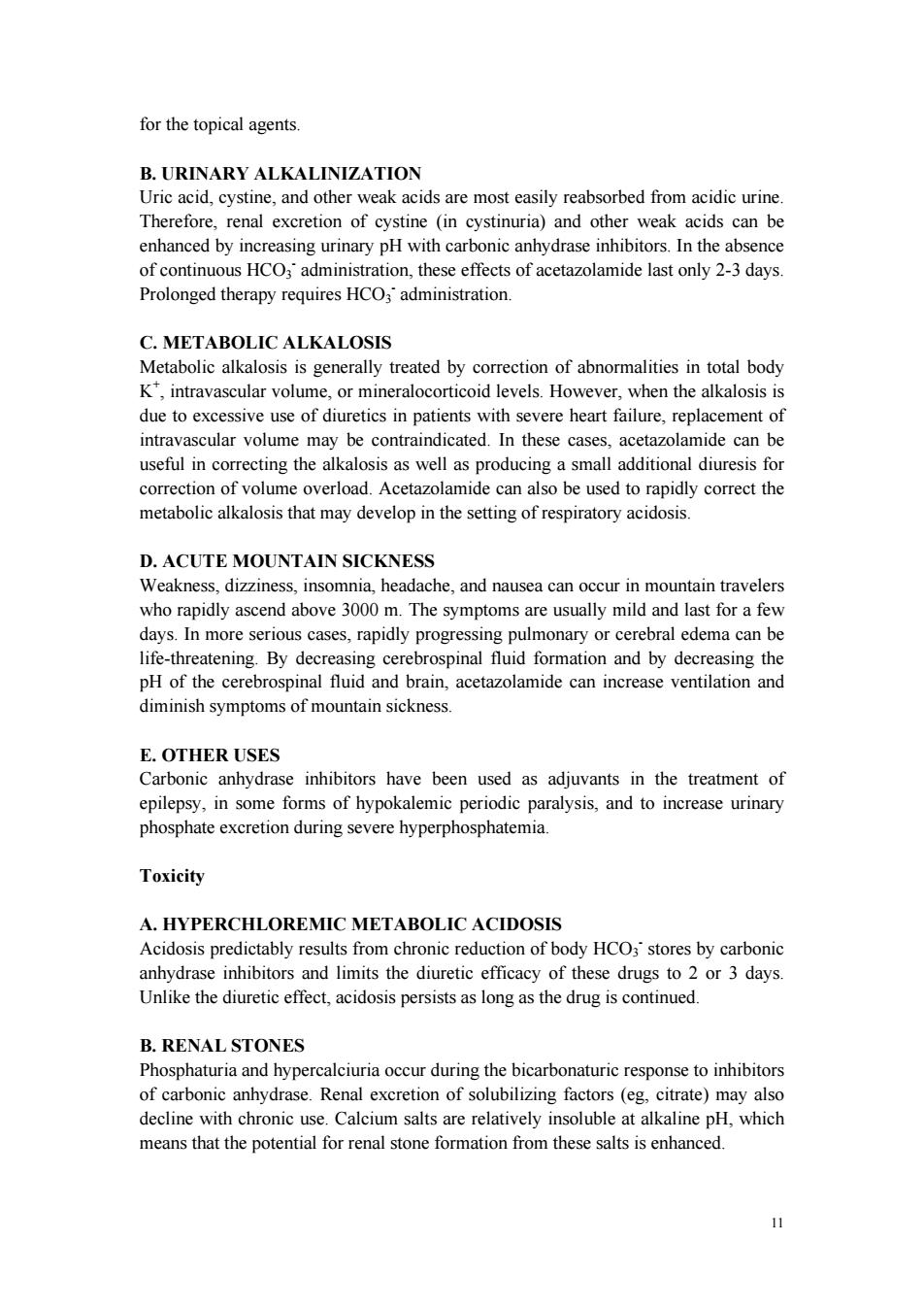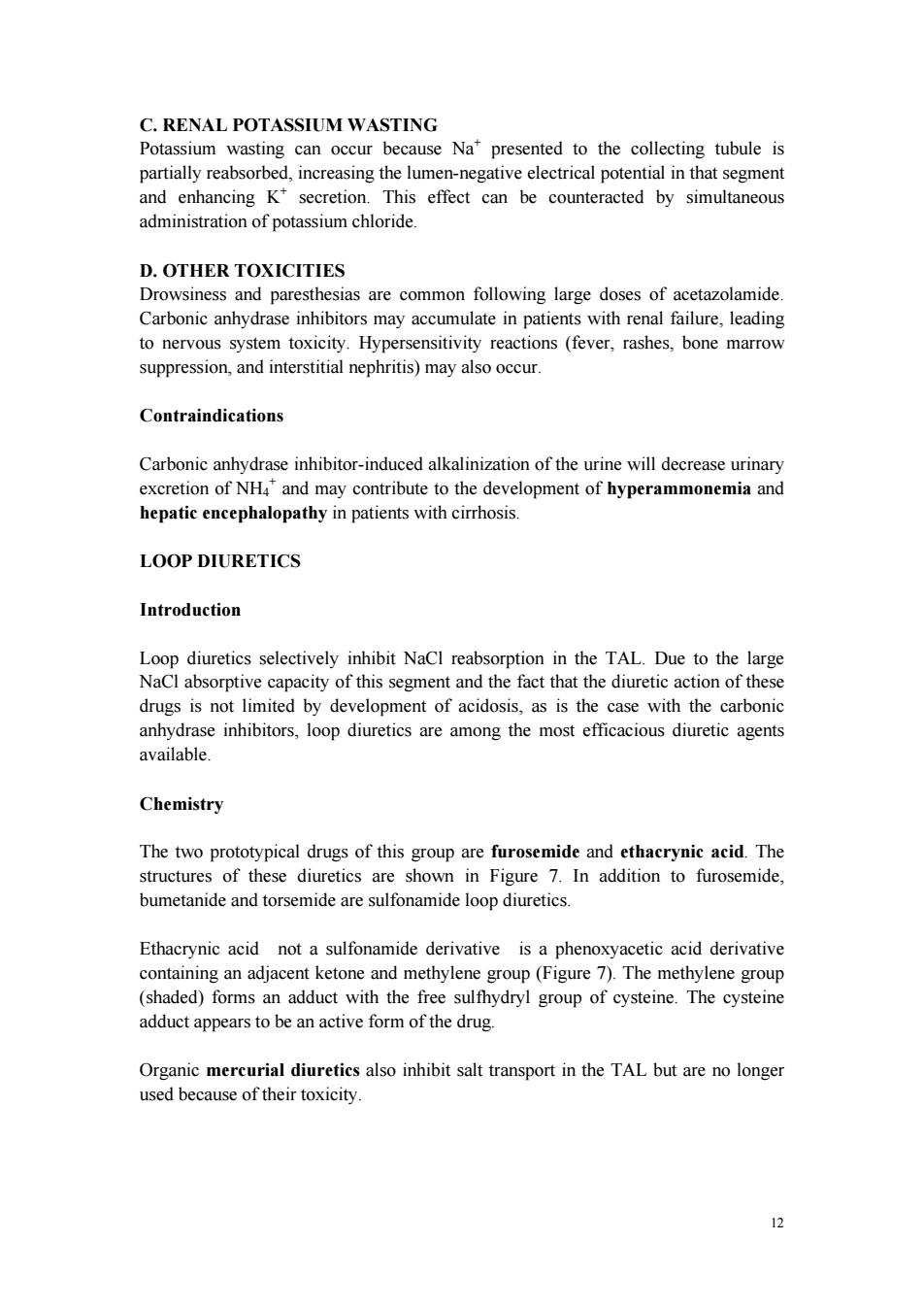
for the topical agents. B.URINARY ALKALINIZATION Uric acid,cystine,and other weak acids are most easily reabsorbed from acidic urine. Therefore,renal excretion of cystine (in cystinuria)and other weak acids can be enhanced by increasing urinary pH with carbonic anhydrase inhibitors.In the absence of continuous HCO3 administration,these effects of acetazolamide last only 2-3 days. Prolonged therapy requires HCO3 administration. C.METABOLIC ALKALOSIS Metabolic alkalosis is generally treated by correction of abnormalities in total body K*,intravascular volume,or mineralocorticoid levels.However,when the alkalosis is due to excessive use of diuretics in patients with severe heart failure,replacement of intravascular volume may be contraindicated.In these cases,acetazolamide can be useful in correcting the alkalosis as well as producing a small additional diuresis for correction of volume overload.Acetazolamide can also be used to rapidly correct the metabolic alkalosis that may develop in the setting of respiratory acidosis. D.ACUTE MOUNTAIN SICKNESS Weakness,dizziness,insomnia,headache,and nausea can occur in mountain travelers who rapidly ascend above 3000 m.The symptoms are usually mild and last for a few days.In more serious cases,rapidly progressing pulmonary or cerebral edema can be life-threatening.By decreasing cerebrospinal fluid formation and by decreasing the pH of the cerebrospinal fluid and brain,acetazolamide can increase ventilation and diminish symptoms of mountain sickness. E.OTHER USES Carbonic anhydrase inhibitors have been used as adjuvants in the treatment of epilepsy,in some forms of hypokalemic periodic paralysis,and to increase urinary phosphate excretion during severe hyperphosphatemia. Toxicity A.HYPERCHLOREMIC METABOLIC ACIDOSIS Acidosis predictably results from chronic reduction of body HCO3 stores by carbonic anhydrase inhibitors and limits the diuretic efficacy of these drugs to 2 or 3 days. Unlike the diuretic effect,acidosis persists as long as the drug is continued. B.RENAL STONES Phosphaturia and hypercalciuria occur during the bicarbonaturic response to inhibitors of carbonic anhydrase.Renal excretion of solubilizing factors (eg,citrate)may also decline with chronic use.Calcium salts are relatively insoluble at alkaline pH,which means that the potential for renal stone formation from these salts is enhanced. 11
11 for the topical agents. B. URINARY ALKALINIZATION Uric acid, cystine, and other weak acids are most easily reabsorbed from acidic urine. Therefore, renal excretion of cystine (in cystinuria) and other weak acids can be enhanced by increasing urinary pH with carbonic anhydrase inhibitors. In the absence of continuous HCO3 - administration, these effects of acetazolamide last only 2-3 days. Prolonged therapy requires HCO3 - administration. C. METABOLIC ALKALOSIS Metabolic alkalosis is generally treated by correction of abnormalities in total body K+ , intravascular volume, or mineralocorticoid levels. However, when the alkalosis is due to excessive use of diuretics in patients with severe heart failure, replacement of intravascular volume may be contraindicated. In these cases, acetazolamide can be useful in correcting the alkalosis as well as producing a small additional diuresis for correction of volume overload. Acetazolamide can also be used to rapidly correct the metabolic alkalosis that may develop in the setting of respiratory acidosis. D. ACUTE MOUNTAIN SICKNESS Weakness, dizziness, insomnia, headache, and nausea can occur in mountain travelers who rapidly ascend above 3000 m. The symptoms are usually mild and last for a few days. In more serious cases, rapidly progressing pulmonary or cerebral edema can be life-threatening. By decreasing cerebrospinal fluid formation and by decreasing the pH of the cerebrospinal fluid and brain, acetazolamide can increase ventilation and diminish symptoms of mountain sickness. E. OTHER USES Carbonic anhydrase inhibitors have been used as adjuvants in the treatment of epilepsy, in some forms of hypokalemic periodic paralysis, and to increase urinary phosphate excretion during severe hyperphosphatemia. Toxicity A. HYPERCHLOREMIC METABOLIC ACIDOSIS Acidosis predictably results from chronic reduction of body HCO3 - stores by carbonic anhydrase inhibitors and limits the diuretic efficacy of these drugs to 2 or 3 days. Unlike the diuretic effect, acidosis persists as long as the drug is continued. B. RENAL STONES Phosphaturia and hypercalciuria occur during the bicarbonaturic response to inhibitors of carbonic anhydrase. Renal excretion of solubilizing factors (eg, citrate) may also decline with chronic use. Calcium salts are relatively insoluble at alkaline pH, which means that the potential for renal stone formation from these salts is enhanced

C.RENAL POTASSIUM WASTING Potassium wasting can occur because Na presented to the collecting tubule is partially reabsorbed,increasing the lumen-negative electrical potential in that segment and enhancing K*secretion.This effect can be counteracted by simultaneous administration of potassium chloride. D.OTHER TOXICITIES Drowsiness and paresthesias are common following large doses of acetazolamide. Carbonic anhydrase inhibitors may accumulate in patients with renal failure,leading to nervous system toxicity.Hypersensitivity reactions (fever,rashes,bone marrow suppression,and interstitial nephritis)may also occur. Contraindications Carbonic anhydrase inhibitor-induced alkalinization of the urine will decrease urinary excretion of NH4"and may contribute to the development of hyperammonemia and hepatic encephalopathy in patients with cirrhosis. LOOP DIURETICS Introduction Loop diuretics selectively inhibit NaCl reabsorption in the TAL.Due to the large NaCl absorptive capacity of this segment and the fact that the diuretic action of these drugs is not limited by development of acidosis,as is the case with the carbonic anhydrase inhibitors,loop diuretics are among the most efficacious diuretic agents available. Chemistry The two prototypical drugs of this group are furosemide and ethacrynic acid.The structures of these diuretics are shown in Figure 7.In addition to furosemide, bumetanide and torsemide are sulfonamide loop diuretics. Ethacrynic acid not a sulfonamide derivative is a phenoxyacetic acid derivative containing an adjacent ketone and methylene group(Figure 7).The methylene group (shaded)forms an adduct with the free sulfhydryl group of cysteine.The cysteine adduct appears to be an active form of the drug. Organic mercurial diuretics also inhibit salt transport in the TAL but are no longer used because of their toxicity 2
12 C. RENAL POTASSIUM WASTING Potassium wasting can occur because Na+ presented to the collecting tubule is partially reabsorbed, increasing the lumen-negative electrical potential in that segment and enhancing K+ secretion. This effect can be counteracted by simultaneous administration of potassium chloride. D. OTHER TOXICITIES Drowsiness and paresthesias are common following large doses of acetazolamide. Carbonic anhydrase inhibitors may accumulate in patients with renal failure, leading to nervous system toxicity. Hypersensitivity reactions (fever, rashes, bone marrow suppression, and interstitial nephritis) may also occur. Contraindications Carbonic anhydrase inhibitor-induced alkalinization of the urine will decrease urinary excretion of NH4 + and may contribute to the development of hyperammonemia and hepatic encephalopathy in patients with cirrhosis. LOOP DIURETICS Introduction Loop diuretics selectively inhibit NaCl reabsorption in the TAL. Due to the large NaCl absorptive capacity of this segment and the fact that the diuretic action of these drugs is not limited by development of acidosis, as is the case with the carbonic anhydrase inhibitors, loop diuretics are among the most efficacious diuretic agents available. Chemistry The two prototypical drugs of this group are furosemide and ethacrynic acid. The structures of these diuretics are shown in Figure 7. In addition to furosemide, bumetanide and torsemide are sulfonamide loop diuretics. Ethacrynic acid not a sulfonamide deri vative is a phenoxyacetic acid derivative containing an adjacent ketone and methylene group (Figure 7). The methylene group (shaded) forms an adduct with the free sulfhydryl group of cysteine. The cysteine adduct appears to be an active form of the drug. Organic mercurial diuretics also inhibit salt transport in the TAL but are no longer used because of their toxicity